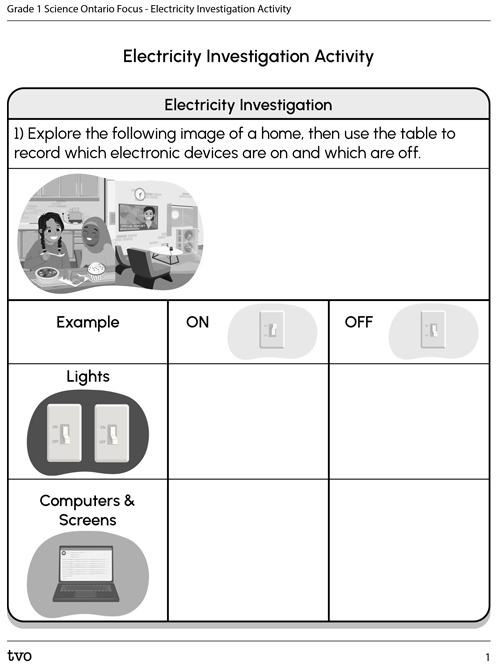Minds On
Using electricity
Electricity is a type of energy that gives power and is used in many ways, for example to power lights, computers, cars, and more!
Have you ever thought about all the ways you use electricity in a day, or how the electricity is made? Some students talk with Ontario Power Generation to think about the ways they use and can save electricity.
Brainstorm
My morning routine
Think about your morning routine.
- Did you use anything that needed electricity?
- How many things did you use that need electricity?
Record your response using a method of your choice.
Action
Investigate!
This learning activity highlights people, places, or innovations that relate directly to the province of Ontario. Enjoy the exploration!

In many communities across Ontario, electricity is used in homes and in schools.
Explore the following images of a home and a classroom. Notice how electricity is being used.

Scenes of how a home uses electricity. On the left, a toaster is plugged into the wall. On the right, there is a T V, a phone charging on a table, and multiple electric fans running.

A scene of how a classroom uses electricity. The students each have a laptop, a smart board is plugged in, and an air conditioner unit is also plugged in.
You are now going to investigate how electricity was being used in the two previous images.
Using the following fillable and printable template or using any method of your choice, complete the Electricity Investigation activity.

Press the Activity button to access the Electricity Investigation Activity.
Activity (Open PDF in a new tab)Did You Know?
Did you know?
Did you know that even when we aren’t using something, if it is plugged in, that it is still using a little bit of electricity?
Making a plan
It’s time to take what we have learned about saving electricity and make a plan! Follow the steps below to complete your plan.
First, decide on one example of how to save electricity.
Next, think about about why it’s important.
Finally, think about what action needs to happen.
An action is something that people can do. In this case your action will be what one thing people can do to save electricity.
For example:

An example of how to save electricity. My example: use less light. Why it's important: using less light will use less electricity. My action: Every time I leave the room, I will turn the light off.
Now it’s your turn!
Press ‘Hint’ to access some ways you can save electricity.
Ways to save electricity might include:
- Using one light or appliances at a time
- Unplug any appliances or turn off that you are not using
- Keeping windows and blinds closed during very hot and cold times of the year
- Playing outside when possible, instead of using electronic devices (i.e. television, tablets)
Complete the “Electricity Plan” in your notebook or using the following fillable and printable document. If you would like, you can use speech-to-text or audio recording tools to record your thoughts.
|
My Example |
|
|
Why It’s Important |
|
|
My Action |
Complete Electricity Plan in your notebook or using the following fillable and printable document.
Press the ‘Activity’ button to access the Electricity Plan.
Now that you have created a plan, it’s time to share it!
Consolidation
Communicate your results!

Now that you have gathered observations and thought about using electricity, it’s time to share with others!
Using a method of your choice, create a poster or record an announcement to tell people of one change that you think everyone can make to save electricity, in your community or a community near by.
Students at Dunwich-Dutton PS and many other schools in Ontario participate in Lights Off Lunches to save energy at their school. They turn off the lights at lunch and open the curtains and blinds. This is part of their EcoSchool certification to reduce their impact on the environment.
What other changes can you think of?
Use the following checklist to guide your creation of a poster or announcement.
Creating a poster or announcement
A good poster will have…
A good announcement will have…
Reflection
How do you feel about what you have learned in this activity? Which of the next four sentences best matches how you are feeling about your learning? Press the button that is beside this sentence.
I feel...
Now, record your ideas about your feelings using a voice recorder, speech-to-text, or writing tool.